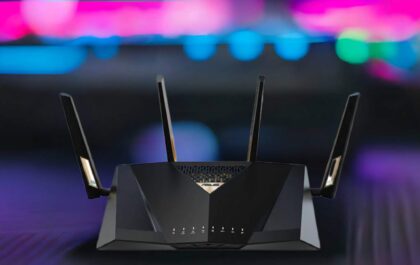We are moving away from both Tomato and DD-WRT, as both projects have seen limited development, and do not support the latest features like Wi-Fi 6 and WireGuard. If you’re looking for an updated list of models, please visit our list of the most popular routers.
Lots of people search the web for the best way to unlock the power of their router. Usually, they come across guides about flashing routers with new firmware, but how do you choose the best one? In this case, the best options seem to be split between two popular options: DD-WRT and Tomato.

Quick Overview
Looking for routers with the best custom firmware? FlashRouters has fully featured DD-WRT routers to super-charge your whole network!
Best DD-WRT FlashRouters
NordLynx WiFi 6 Router – Privacy Hero – Perfect for Medium Homes / Perfect for 20-30 Devices / Built-in Support for WireGuard & Wi-Fi 6 / Exclusive Router Support for NordLynx SALE PRICE: $189.99 $249.99 | BUY NOW
Asus RT-BE88U WiFi 7 Merlin FlashRouter – Upgraded with Custom Merlin Firmware. / Next Gen WiFI 7 Update of Asus favorite model. / Wireguard & OpenVPN Compatible. / Works worldwide. SALE PRICE: $359.99 $499.99 | BUY NOW
What Does Custom Router Firmware Offer?
Custom firmware boosts the functionality of the router that it is installed on. Both DD-WRT and Tomato custom firmware aims to fix flaws found in off-the-shelf software, while also offering hidden features that would normally be locked away. These two custom options are both excellent router upgrades, but both kinds of open-source firmware have considerable differences.
We’re going to explore some of the differences below, in the hope of offering our customers a clearer picture of each open-source firmware and allowing our customers the ability to have a better idea of which is the best router firmware for them.

The Benefits DD-WRT and Tomato Share
As we mentioned above, both DD-WRT and Tomato open-source firmware share a lot of virtues. For one, they both allow users to access advanced features like the ability to extend your wireless range, tweak wireless sensitivity, and control your bandwidth allocation. They also add advanced layers of security that stock firmware simply can’t provide.
If you are interested in easily switching back and forth between two (or more) OpenVPN servers, DD-WRT and Tomato can easily offer that option. While they offer slightly different solutions, as we’ll detail below, both alternative firmware offer users an easy way to switch back and forth between servers. As such, if you have an IPVanish server that works well in New York, and a NordVPN server you prefer in Los Angeles, you can easily hop from one to the other!
If that was all these firmware did, they’d be worth the upgrade, but there’s also all of this:
- Built-in OpenVPN & L2TP Settings which allows you to utilize your VPN subscription with multiple devices, such as popular streaming players like Roku and Firestick, while saving you the trouble of installing the VPN connection on every single device!
- Dual WAN and 4G USB Failover options.
- Major security holes removed like WPS and manufacturer backdoors.
- Advanced Networking Modes for WDS, Repeaters & Client Bridges.
- Advanced QoS (Quality of Service), allowing you to allocate your bandwidth for VOIP services like Zoom, streaming services & popular websites.
That’s a whole lot of features, and that’s just what DD-WRT and Tomato have in common.
Now onto the differences…
DD-WRT Firmware Benefits Unavailable on Tomato
One thing DD-WRT has going for it over Tomato is that DD-WRT is more readily available. Because DD-WRT supports some Atheros-based and Ralink-based chipsets, you can flash DD-WRT on a much wider selection of devices. In fact, top manufacturers such as D-Link, TP-Link, Asus, and more are available with DD-WRT.
Moreover, if you’re interested in wireless repeater modes, DD-WRT has it all over Tomato. DD-WRT offers the use of repeaters on alternate subnets, whereas Tomato only has the repeater bridge/WDS.
Another feature DD-WRT has over Tomato is its Wi-Fi hotspot capability. DD-WRT has more advanced, built-in options for Wi-Fi hotspots than Tomato, such as Wifidog, Sputnik, and many others.
Finally, the Policy-Based Routing setup on DD-WRT is recommended over Tomato. Policy-based routing, or the Dual Gateway Setup, is recommended for use with higher-end routers. Using the Dual Gateway with a high-powered router will allow you to use the router as both an ISP and a VPN connection. This is advantageous because it allows you to keep specific devices off the VPN, while protecting others at the same time, all without having to switch between ISP and VPN in real time.
Additional DD-WRT Benefits
In addition to VPN configuration and enhanced features, all of our DD-WRT FlashRouters come with the FlashRouters Privacy App! While DD-WRT has full VPN integration, it’s not the most user-friendly experience. However, the FR Privacy App makes it a snap to configure and implement your VPN on your wireless network. In fact, it’s even more straightforward than the Tomato user interface! Our app runs directly from any Internet browser on desktop or mobile devices.
This allows for easy tweaking and VPN configuration, including but not limited to:
- Easy device management.
- Seamless VPN server switching.
- Optimized UI on any browser or mobile phone.
- Kill switch and VPN bypass by device.
-
Want better support for your entire network? The FlashRouters Privacy App is here to help.
Tomato Firmware Benefits Unavailable on DD-WRT
Tomato offers very good OpenVPN support with most VPN providers. In fact, our testing has shown a high rate of success with Tomato when setting up and connecting with OpenVPN. However, any flaws DD-WRT has in this area are alleviated by using our FR Privacy app.
Tomato is also noteworthy for having a user-friendly graphical user interface, as well as some helpful visual add-ons of connected ethernet devices. There’s also a wireless survey page that helps users find the best channel to use for a wireless network, and Tomato has a feature that notifies users when updates are available. On top of that, Tomato has integrated Tor and BitTorrent clients and even makes USB integration easier.

Tomato is also recommended for bandwidth monitoring use. Tomato offers real-time, 24 hours, daily, weekly, and monthly bandwidth monitoring, while DD-WRT only offers real-time bandwidth monitoring. If you have multiple devices on your network, bandwidth monitoring will allow you to see which devices are clogging up your speeds.
So Which Is the Best Router Firmware?
Overall, we find that DD-WRT, coupled with our FlashRouters Privacy App, is a clear winner over the Tomato router firmware. While Tomato offers some benefits in its user-friendly graphical interface, the other benefits of DD-WRT outweigh them. No matter what feature matters most to you, make sure to check whether DD-WRT or Tomato offers it before you commit to a purchase or flash your router.
If you’re interested in having your current router flashed with DD-WRT firmware, we can help, with our Flash My Router service! Trust the professionals. We Flash Routers.
Got questions about DD-WRT or Tomato Custom firmware? Ask us anytime!







